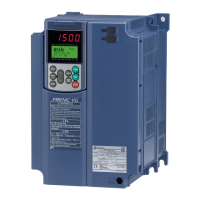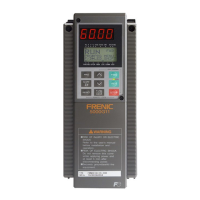6-15
Chap. 6 TROUBLESHOOTING
Possible Causes What to Check and Suggested Measures
(2) Activation level for the
electronic thermal protection
was inadequate.
Check the continuous allowable current of the motor.
Î Reconsider and change the data of function code F11*.
(3) The specified acceleration/
deceleration time was too
short.
Recalculate the acceleration/deceleration torque and time needed for the load, based
on the moment of inertia for the load and the acceleration/deceleration time.
Î Increase the acceleration/ deceleration time (F07, F08, E10 through E15, and
H56).
(4) Overload. Measure the output current.
Î Reduce the load (e.g. Use the overload early warning (E34) and reduce the load
before the overload protection is activated.). (In winter, the load tends to
increase.)
(5) Excessive torque boost
specified (F09*)
Check whether decreasing the torque boost (F09*) does not stall the motor.
Î If no stall occurs, decrease the F09* data.
[ 15 ]
0lu
Inverter overload
Problem Temperature inside inverter has risen abnormally.
Possible Causes What to Check and Suggested Measures
(1) Temperature around the
inverter exceeded the inverter's
specification range.
Measure the temperature around the inverter.
Î Lower the temperature (e.g., ventilate the panel where the inverter is mounted).
(2) Excessive torque boost
specified (F09*)
Check whether decreasing the torque boost (F09*) does not stall the motor.
Î If no stall occurs, decrease the F09* data.
(3) The specified acceleration/
deceleration time was too
short.
Recalculate the acceleration/deceleration torque and time needed for the load, based
on the moment of inertia for the load and the acceleration/deceleration time.
Î Increase the acceleration/deceleration time (F07, F08, E10 through E15, and
H56).
(4) Overload. Measure the output current.
Î Reduce the load (e.g., Use the overload early warning (E34) and reduce the load
before the overload protection is activated.). (In winter, the load tends to
increase.).
Î Decrease the motor sound (Carrier frequency) (F26).
Î Enable overload prevention control (H70).
Check if there is sufficient clearance around the inverter.
Î Change the mounting place to ensure the clearance.
(5) Ventilation paths are blocked.
Check if the heat sink is not clogged.
Î Clean the heat sink.
Check the cumulative run time of the cooling fan. Refer to Chapter 3, Section 3.4.6
"Reading maintenance information – Menu #5 "Maintenance Information"."
Î Replace the cooling fan.
(6) Cooling fan's airflow volume
decreased due to the service
life expired or failure.
Visually check that the cooling fan rotates normally.
Î Replace the cooling fan.
(7) The wires to the motor are too
long, causing a large leakage
current from them.
Measure the leakage current.
Î Insert an output circuit filter (OFL).
[ 16 ]
05
Overspeed
Problem The motor rotates in an excessive speed (Motor speed ≥ (F03 data) × (d32 data, d33 data) × 1.2)
Possible Causes What to Check and Suggested Measures
Check the motor parameter "Number of poles" (P01*).
Î Specify the P01* data in accordance with the motor to be used.
Check the maximum frequency setting (F03*).
Î Specify the F03* data in accordance with the output frequency.
(1) Incorrect setting of function
code data.
Check the setting of speed limit function (d32 and d33).
Î Disable the speed limit function (d32 and d33).
(2) Insufficient gain of the speed
controller.
Check whether the actual speed overshoots the commanded one in higher speed
operation.
Î Increase the speed controller gain (d03*.)
(Depending on the situations, reconsider the setting of the filter constant or the
integral time.)

